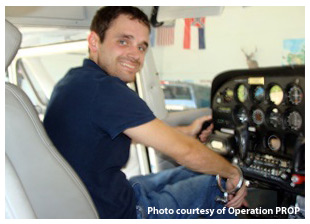Training Tips
|

'Pilots are encouraged'
It doesn't take long for a student pilot to become accustomed to the pleasant routine of preparing the trainer for flight. Elements that recently seemed mysterious now feel comfortable and familiar. When something looks out of place, you spot it easily.
Today as you prepare to head to the practice area, all seems status quo until you turn on the radios. One is tuned as usual to your nontowered airport's common traffic advisory frequency. But the other, usually set to the nearby approach control facility frequency, is on 121.5 MHz.
Did the aircraft have an emergency?
Not necessarily. Perhaps the pilot was checking to see if the aircraft's emergency locator transmitter, or another nearby, had activated. Also, the Aeronautical Information Manual notes that "pilots are encouraged" to monitor the frequency during flight to help identify possible ELT transmissions. Do you recall the four items that should be reported to air traffic control if you hear an ELT's shrill tone on the radio? You should report your position at the time the signal was first heard, position at the time the signal was last heard, position at maximum signal strength, and flight altitudes and frequency on which the emergency signal was heard (121.5 MHz, or 243.0 MHz for military aircraft).
Monitoring 121.5 MHz is one of many actions the FAA encourages pilots to take—for flight safety and to increase their understanding of the ATC system—but does not require.
What else does the FAA encourage?
It is encouraged, for example, to turn on landing lights "after takeoff clearance has been received or when beginning takeoff roll," as well as "when operating below 10,000 feet, day or night, especially when operating within 10 miles of any airport, or in conditions of reduced visibility and in areas where flocks of birds may be expected, i.e., coastal areas, lake areas, around refuse dumps, etc."
At a towered airport, when should an aircraft that has taxied to the runway change from ground control to the tower? Unless otherwise advised, change from ground to local control "when ready to request takeoff clearance." But also note that "pilots are encouraged to monitor the local tower frequency as soon as practical consistent with other ATC requirements."
The FAA also encourages pilots to visit ATC facilities to become more familiar with how the system operates (see AIM 4-1-6).
|
|
|
|
Flight Training News
|
|
Facebook chat
What are your 2015 flying goals?
What are your flying goals for 2015? Whether they're to finish your pilot certificate, add a new rating, or fly to all 50 states, Flight Training editors Ian J. Twombly and Jill W. Tallman can give you some ideas on how to get there. Join them for the next live Flight Training Facebook chat at 3 p.m. Eastern time on Dec. 2. One chatter will receive a $50 PilotShop.com gift card. Set an email reminder here. Flight Training Facebook chats are underwritten by Aircraft Spruce & Specialty.

Article
Giving an injured U.S. Marine a taste of the freedom of flight set a Mississippi pilot on a course to do much more. Linwood Nooe created a nonprofit organization in part to give more people a chance to overcome adversity and fly, and now hopes to put hand controls back into production. Read more...
 
Safety Spotlight
You're eager to learn more, but how do you find the information appropriate for a particular stage of your flight training journey? Whether you're in need of a refresher on towered airport operations or proper radio etiquette, the Air Safety Institute has your back. Learn more...
 
Article
More people are learning to fly later in life, when time and money constraints ease. Few of them, however, take to flying with the zeal of Howard Wolvington, who was named the FAA's 2014 Flight Instructor of the Year. Wolvington learned to fly in his mid-50s after becoming hooked on aviation while learning to fly radio-controlled airplanes with his son. Read more...
 
AOPA Foundation focus
Thanks to a donation from Rod Machado, the AOPA Foundation's online auction now boasts a suite of training materials from Machado's Aviation Learning Center. The items include handbooks, workbooks, audiobooks, and DVDs; all feature that unique blend of humor and aviation knowledge for which Machado is well known. Proceeds from the auction, which closes Dec. 19, will support the foundation's ongoing efforts to preserve the future of general aviation. Check out these and other training products up for bid...
|
|
|
Training Resources
|
|
Pilot Safety Announcement
Before hopping into the airplane this season, be prepared to resist pressures to complete a trip no matter what. For a quick antidote, watch the Air Safety Institute's rhyme for the unwary flier—a darkly humorous reminder of ills that can befall the careless pilot. Make sure your name isn't next on the list. Watch the video...
 
|
|
Did you know that student pilots who join AOPA are three times more likely to complete their flight training? Membership includes unlimited access to aviation information by phone (800/USA-AOPA, weekdays from 8:30 a.m. to 8 p.m. Eastern time) or from Flight Training Online or AOPA Online. If you're not already a member, join today and get the pilot's edge.
|
|
|
AOPA Live
|
|
AOPA Live This Week
The DC-3 based at St. Simons Island, Georgia, has a long and colorful history. It landed a film role with John Travolta, and represented the iconic Douglas design on a world tour. This airplane's current owner continues to put it to work inspiring the next generation. Plus, a camera rides along with Patty Wagstaff (and so can you), and learn the how and why of staying on centerline. AOPA Live This Week®, Nov. 27...
 
|
|
Career Pilot
|

Article
When Mike Ott's dad took him up for his first airplane ride in a Piper Cherokee, little could he imagine that his current flying job would attract worldwide attention. Read more...
 
Virgin America stock soars
Shares of Virgin America Inc. were up 50 percent less than a week after their Nov. 14 initial public offering, CNN Money reported. CNN said strong demand for business and leisure travel as well as lower fuel prices have helped make airlines one of the best-performing sectors in 2014, and Virgin America benefited from similarities with hot tech stocks.
|
|
For more aviation career news, see the Flight Training website.
|
|
|
Plane Spotter
|

'High utilization'
Something about the look of regional jets just projects their capability to speed between city pairs, get quick-turned at the gate, and do it again, all day. That 50-seater with two Rolls-Royce AE 3007 turbofan engines pylon-mounted on either side of the rear fuselage, and a distinctively swept T-tail can be logged in a plane spotter's notes as a Brazilian-built Embraer ERJ 145, largest of an aircraft family constructed for "high utilization." In the jet universe, that means takeoff-and-landing cycles aplenty: The ERJ 145 is built for a 60,000-cycle design life.
|
Training Products
|
Where to fly? Book offers Western US destinations
Pilots looking for adventurous destinations in the Western United States can find flying ideas in Fifty Classic Destinations For Pilots, by Ney Grant of westcoastflyingadventures.com. The full-color, 190-page book covers destinations including Friday Harbor, Washington, and Yellowstone National Park, with information about how Ney uses his Cessna T210 to hike, backpack, go canyoneering, photograph, volunteer, or visit bed and breakfasts at these destinations. It is available online for $49.95, with a Black Friday special price of $39.96 through Nov. 30.
|
|
Note: Products listed have not been evaluated by ePilot editors unless otherwise noted. AOPA assumes no responsibility for products or services listed or for claims or actions by manufacturers or vendors.
|
Member Benefits
|
|
Members only
How do the FAA's medical certification folks look at airmen who have had a stroke? Current FAA policy denies medical certification for two years after such an event. Once that time has passed, pilots can apply for a medical but must supply the appropriate paperwork. Find out what kind of tests and reports you'll need to provide. Read more...
 
|
|
|
Blogs
|
|
The January issue of Flight Training goes "back to basics." Few things are more basic in aviation than the takeoff—do your takeoffs make you look good? Also, there are a lot of sayings in aviation, but the magazine has distilled some very basic truisms that can be applied to your daily flying and make you a better pilot. Read more...
 
|
|
|
Instrument Tip
|
|
IFR Fix
Your CFII usually follows up route-planning drilling with a review of appropriate regulations, and today's selection is 14 CFR 91.185, "IFR Operations: Two-way radio communications failure." Read more...
 
|
Final Exam
|
Question
Private pilots are allowed to perform preventive maintenance on any aircraft they own or operate, provided it isn't used in air carrier service. Where can a pilot find the list of items considered to be preventive maintenance?
Answer
Preventive maintenance items can be found in Appendix A, Paragraph C of Part 43 of the federal aviation regulations.
|
|
Got a question for our technical services staff? Contact AOPA.
|
Career Opportunities
|
|
Aviation job board
Aviation is all about community, and Cirrus Aircraft is currently seeking a dynamic talent to lead the Cirrus brand community. The community manager will implement online community strategy, manage engagement and interactivity with the audience, and foster community spirit. This role coordinates with the internal Marketing teams to support their respective missions, ensuring consistency in voice and cultivating a strong community around the brand. Learn more about this unique career opportunity.
AOPA career opportunities
Ever dream of turning your passion for aviation into a career? We're looking for an associate editor— Web/ePilot, coordinator for pilot community development, program manager for flight training initiatives, senior advertising sales/account executive, senior financial analyst, digital marketing manager, major gift officer, senior ambassador, ambassador for Southern California, .Net applications developer, social media evangelist, legal services plan program manager, and account manager II. To learn more about other AOPA career opportunities, visit AOPA Online.
|
 |
Education and Seminars
|
Flight Instructor Refresher Courses
Dec 6-7 - Orlando, Florida; Northbrook, Illinois; and Denver, Colorado
Jan 3-4 - Charlotte, North Carolina; Portland, Oregon; and Ypsilanti, Michigan
Jan 10-11 - San Antonio, Texas; Long Beach, California; Knoxville, Tennessee; and Bellevue, Washington
Jan 17-18 - Santa Clara, California; Ridgeland, Mississippi; and Baltimore, Maryland
For a complete schedule, see AOPA Online. Can't make it in person? Sign up for the Air Safety Institute's Online eFIRC.
|
Air Safety Institute Safety Seminars
Jan 5 - Mesa, Arizona; and Reno, Nevada
Jan 6 - Sacramento, California; and Tucson, Arizona
Jan 7 - El Paso, Texas; and Milpitas, California
Jan 8 - Santa Rosa, California; and Albuquerque, New Mexico
Topics vary—for details and a complete schedule, see AOPA Online.
|
Rusty Pilot Seminars
Jan 8 - Carlsbad, California
Jan 10 - Farmingdale, New York
Jan 17 - Keene, New Hampshire
For a complete schedule, see AOPA Online.
|
|
|
|
|
|
|
|
|
|
ePilot Flight Training Editors:
Sarah Deener
Alyssa Miller
Jim Moore
Production Assistant:
Melissa Whitehouse |
Contributors:
Jill W. Tallman
Warren Morningstar
Alton K. Marsh
Dave Hirschman
Tom Horne
Ian J. Twombly
Dan Namowitz |
|
|
|
|